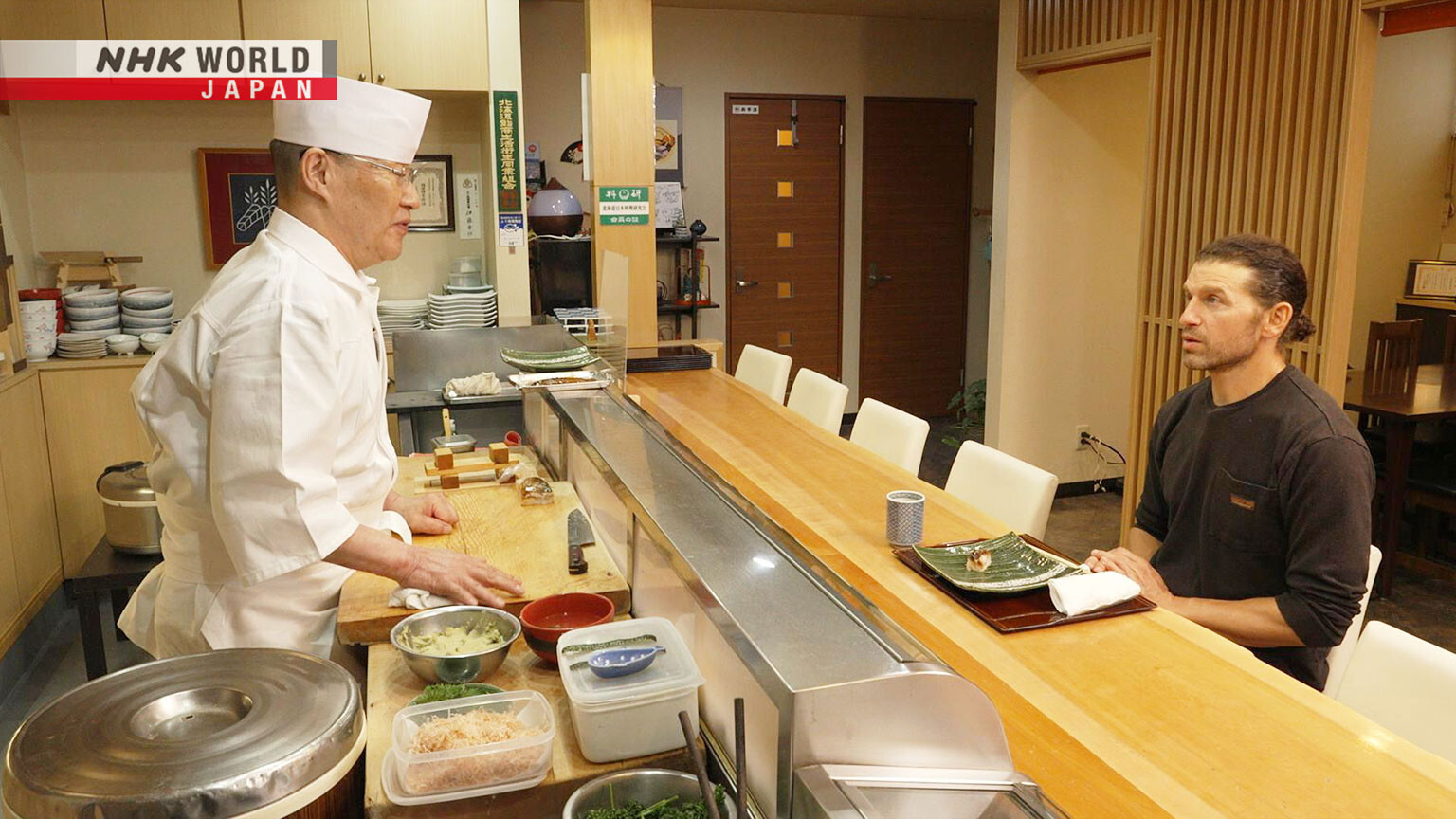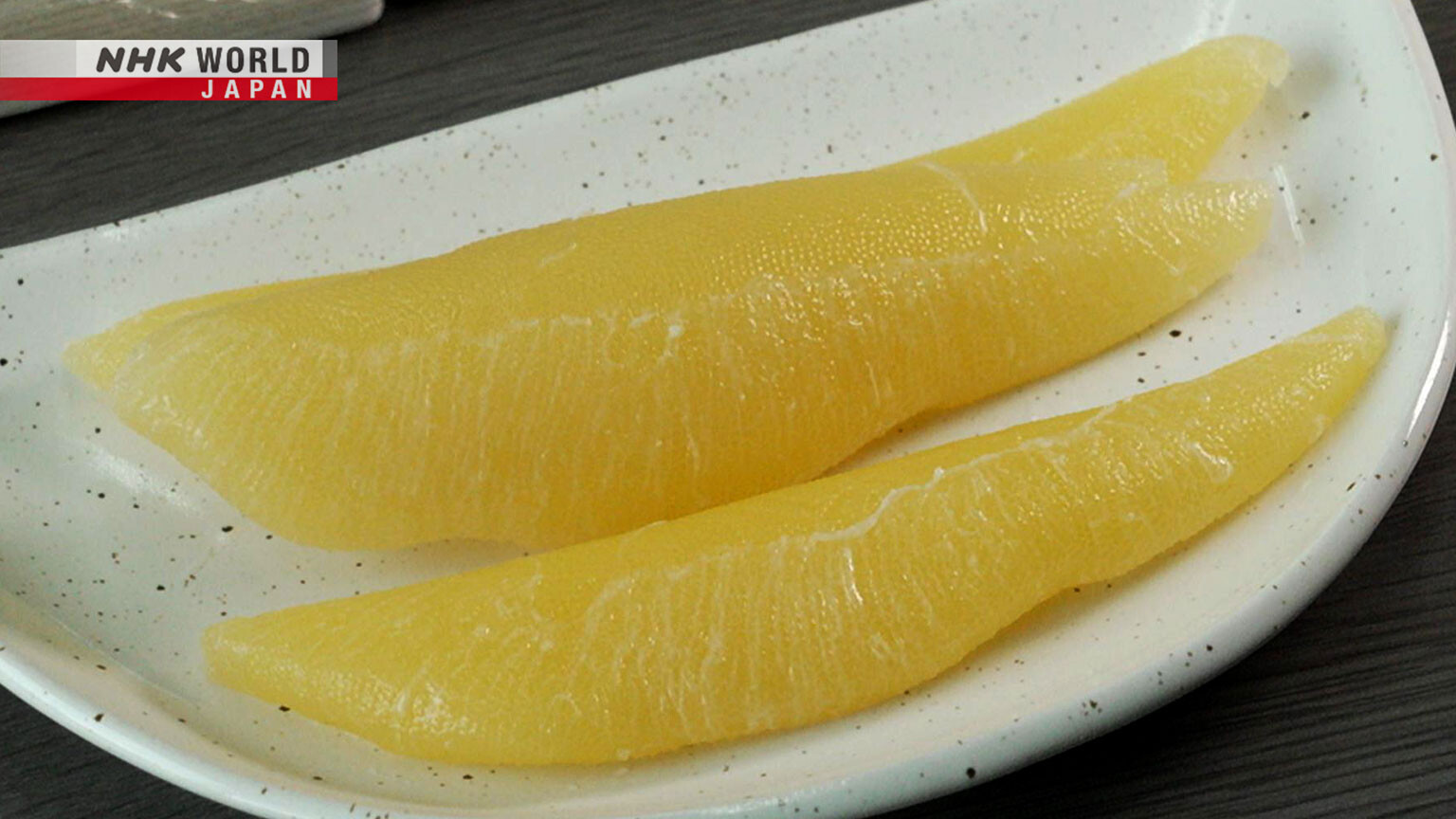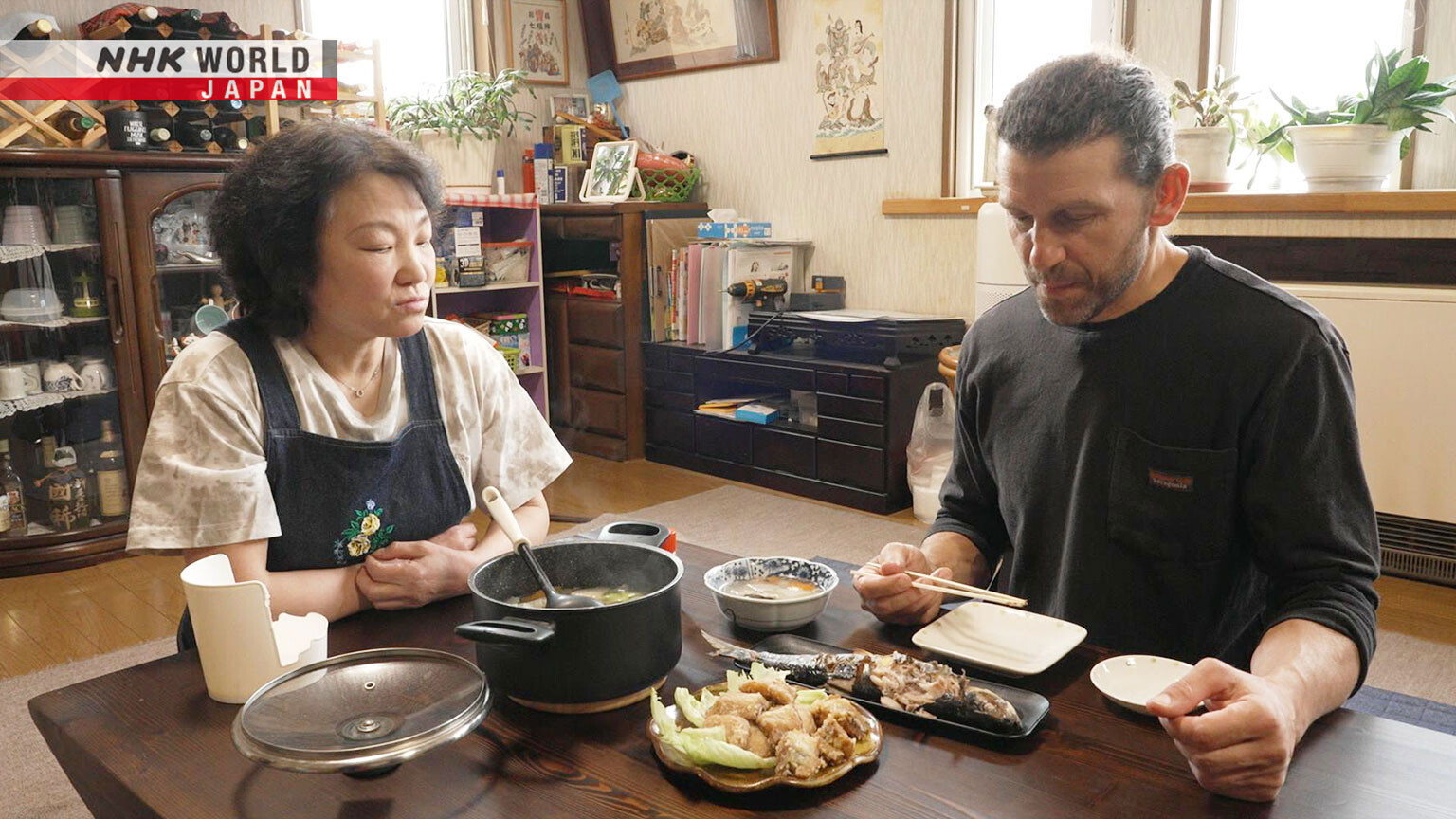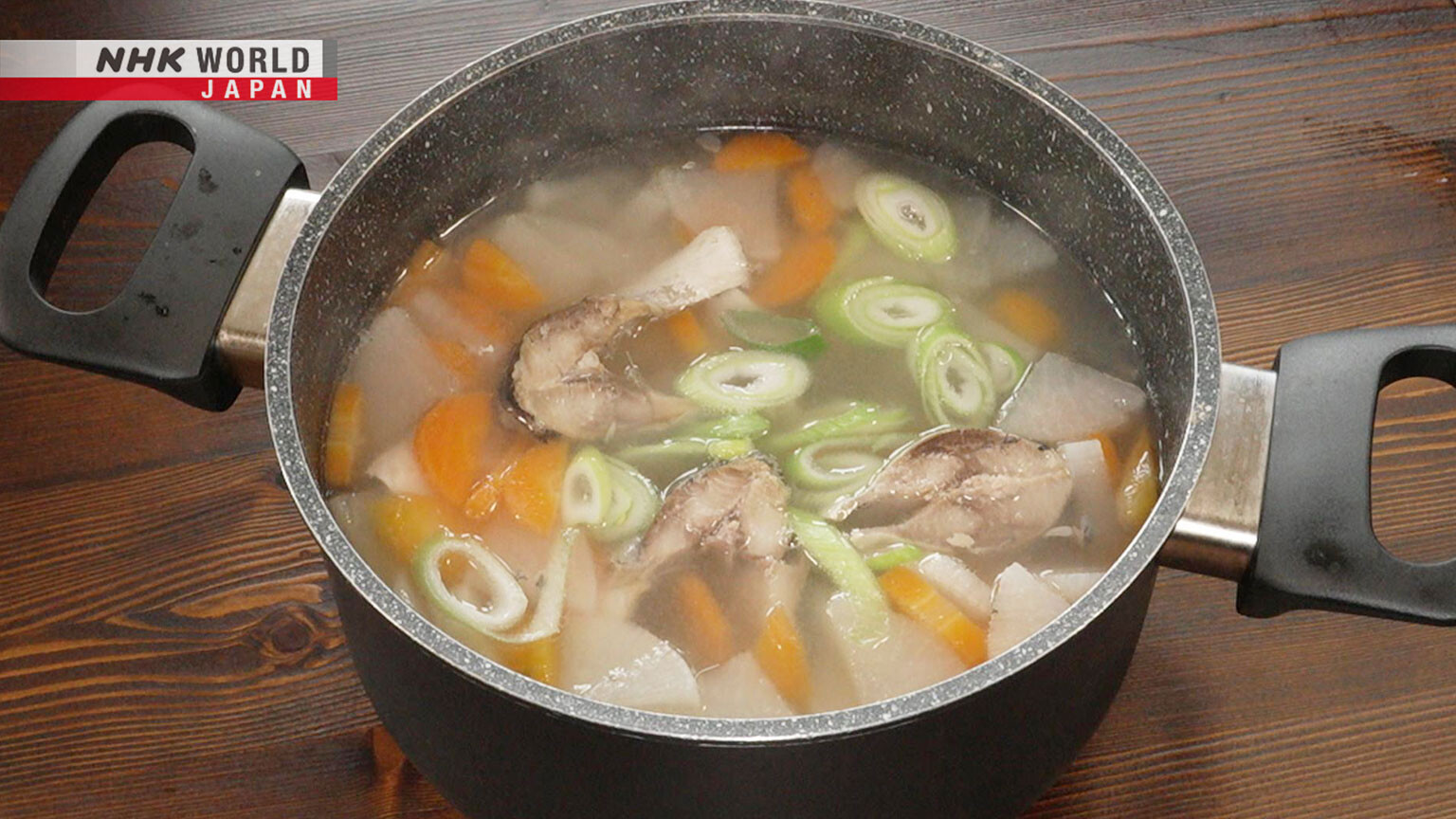NISHIN
Schools of nishin, or Pacific herring, enter Japan's cooler northern waters in spring. Once a lucrative part of local economies, the fish remains a staple ingredient in various Japanese dishes. (Reporter: Michael Keida)




Transcript
Tokyo: this world-class metropolis is a veritable gourmet wonderland.
Discover the stories behind the ingredients that make this city so delicious - so "oishii."
This time, we focus on nishin, or Pacific herring in English.
Schools enter Japan's northern waters when spring comes.
In northern Europe, it's often cured in salt and vinegar.
In Japan, it's been eaten in various ways since ancient times,
and is deeply embedded in the country's food culture.
- "Oishii."
- Yeah?
Ah, it's so good.
There's a lot!
You think so?
In the past, nishin was a great source of wealth in Japan - this has left a lasting cultural and historical legacy.
Dive in to discover more about nishin, the fish of spring!
Trails to Oishii Tokyo.
Hi, I'm Michael Keida.
I'm originally from America, but I've been living in Japan for 19 years now.
Today we're in Tsukiji to check out nishin.
Now, nishin has a lot of history and is embedded into the culture in Japan, but me personally, I don't know it very well.
So, I've come here to find out more. Let's get started.
Michael visits the Tsukiji Outer Market.
A popular tourist destination, Tokyo's food pantry is home to around 400 shops.
One corner of the market has a building dedicated to marine products.
There's such a heavy smell of fish, but it's a fresh type of aroma.
Check it out. There's so many different varieties and things that you don't get to see in a regular fish market.
Michael begins at a shop run by a wholesale company that deals in seafood from across Japan.
Moriya Takashi will lead the way.
- These are nishin.
- Here?
They look like big sardines.
Right. They're considered blueback fish, like sardines and certain mackerels.
They're beautiful. Very shiny.
Where do they come from?
- Mostly Hokkaido.
- Up north?
They're in season now.
- They get fatty this time of year.
- I see.
Nishin are found in the cold waters of the Pacific, Atlantic and Arctic oceans.
They migrate at 100 to 200 meters deep.
In Japan, it's known as a fish that heralds spring,
as schools come to lay eggs in seaweed along the coast when the season arrives.
What's special about nishin?
Affordable, but rich and tasty.
They're so fatty that they spoil quickly.
I see. So they can't be shipped long distances?
Freezing technology makes it possible now. In the past, they were processed first.
Before the development of freezing and logistics technology, dried migaki nishin was mainstream across the country.
Fish meat is dry-preserved once the innards are removed.
There's another processed food made from nishin that remains a key part of Japan's food culture.
Have you heard of kazunoko?
- Oh, is it nishin roe? Eaten on New Year's?
- Exactly.
I always wondered what fish it was.
- Kazunoko.
- Nishin roe.
Kazunoko, which is considered a luxury in Japan, is nishin roe cured in salt.
Since nishin produce a large number of eggs, kazunoko symbolizes generational health,
and is therefore an essential part of New Year's menus.
As you can see, nishin are important in Japanese tradition.
Michael heads to Hokkaido, where 99% of Japan's nishin are landed.
It's a four-hour trip from Tokyo by plane and car.
He arrives at Rumoi, a thriving port town famous for nishin that faces the Sea of Japan.
To try some nishin dishes, Michael visits a local Japanese restaurant.
Chef and Rumoi native Ito Yukihiro has over 50 years of experience.
He begins with sashimi.
Nishin have a lot of thin bones.
Cutting them is a delicate process.
Here you are.
Sashimi.
Wow, it looks beautiful.
Light-red fish meat with shiso leaves in between, laid out like tree leaves.
- Itadakimasu.
- Enjoy.
- Crunchy?
- "Oishii."
It has a great kind of crunchy texture to it but it also melts and it's very delicate.
And the flavor's just a very mild... similar to sardines, but it actually has almost less of a fishiness to it.
- I could hear the bones being cut.
- Right.
But they don't bother me as I eat.
They're softer than I expected.
Now, he makes several fine incisions into the meat and bones.
This is nishin sushi.
Enjoy it with ginger and soy sauce.
It's sweet on the tongue.
The fat coats the inside of my mouth, and it gets even sweeter.
It's soft and melts in the mouth.
Yes, it's not overly fatty.
It gets fattier when you cook it though. That's the nice thing about nishin.
Next, nishin covered in potato starch is pan-fried in a soy sauce-based sweet sauce.
This is pressed in a mold with rice.
Nishin pressed sushi.
He also added sansho pepper powder.
What a rich flavor.
It's so tender. It just melts in your mouth.
And it's just coated with such a wide variety of flavors.
That's absolutely delicious.
Ito, who is currently 71, has many fond childhood memories with nishin.
The beaches were really crowded. You'd see horses pulling carts of nishin.
Children would follow behind and pick up nishin that had fallen off.
Then we'd take them home and mom would cook them for dinner.
This made mom happy, so we kept going back for more.
The industry peaked in Hokkaido in around the late-19th and early 20th centuries,
reaching an annual catch of about 1 million tons.
That's comparable to all seafood landed in Hokkaido today combined.
The thriving industry attracted workers from outside Hokkaido.
This is a banya, or fisher's house, that was built in 1905.
The building tied to the history of nishin fishing is registered as an important cultural property.
In the past, it served as a residence for around 200 people
including fishers and boat builders who worked together during the fishing season.
Banya houses, built on beaches by wealthy nishin fishers, were known as "nishin palaces."
The luxurious dwellings feature the finest materials and furnishings of the time.
It's incredible, just the luxurious design and build of this structure,
you can tell that nishin brought in a lot of wealth.
Wow.
Banya houses reflect the vast wealth once generated by nishin.
How are things going nowadays?
Michael joins a group of fishers to find out.
- Good morning.
- Good morning.
Abe Kimio is a third-generation fisher with 30 years of experience.
Gill nets are used to catch nishin.
Around 900-meter-long nets are placed along the migration path overnight.
If they choose the right location, they'll catch loads of fish.
If they're off, they won't catch any.
Experience and intuition are the keys to success.
Just before sunrise...
They head out to retrieve the nets.
This has your symbol on it?
Yes, that's ours. All of the buoys are marked.
- That net belongs to someone else.
- I see.
They look for their symbol, and reel in the net.
We got some.
I can see!
This is my first time seeing nishin being fished,
but I see plenty of fish in there but I don't know if this is a good catch or an average catch.
I have to ask him later when he...
once he gets it all up.
- Is this a lot?
- Not really.
- On a good day, the fish completely fill the net.
- I see.
I can see more.
- Good news?
- I think so.
During a good catch, they don't show up one by one like this.
Usually, we'd be grabbing them in clusters.
This looks like a good catch to me.
Nope.
They spend around 30 minutes reeling in the first net, and move on to the next one hoping for a larger catch.
It's exciting. I wonder if they caught anything.
There's actually quite a few nishin coming up.
Oh wow.
- There's a lot!
- You think so?
I think we got more here.
Have you been doing this every year since a young age?
Nishin have only been this plentiful over the last 5 or 6 years.
Before that, I only fished occasionally, when they showed up.
Catches weren't this stable.
Nishin used to be considered rare.
People are happy that nishin came back?
Right.
We're also working to increase the fish population.
I think that's had an impact.
In the mid-20th century, catch numbers fell so low that nishin were deemed phantom fish.
28 years ago, a project began in cooperation with local governments and fishing cooperatives across Hokkaido.
This involved collecting eggs and nurturing juvenile fish in tanks for around 80 days.
Two million fish are released from Hokkaido ports each year.
The effort has paid off, as catch numbers continue to rise.
6:30AM.
Abe and his crew head back to port.
Abe's family and staff are waiting for them at the harbor.
The fish are taken to a nearby workstation, removed from the nets, and separated by gender.
Ones with eggs coming out are females.
We may have to check carefully. The eggs might be translucent.
- You press on the belly a little?
- Yes, to check for eggs.
Females are boxed with their bellies up to keep their eggs from getting crushed.
They brought in four nets today, totaling 800 kilograms of fish.
Was it a good day?
No, we didn't get very much today.
- But that happens sometimes.
- Good days and bad days.
That's the life of a fisher.
What do nishin mean to the people of Rumoi?
To the people of Rumoi, nishin are a real treasure.
Most female nishin are taken to a local processing plant, where their eggs are cured in salt to make kazunoko.
Rumoi is Japan's largest producer of the luxury food.
The leftover fish meat is used to make a traditional preserved food unique to the area.
Here, we make nuka nishin.
It's a traditional preserved food from Hokkaido.
Nuka nishin is said to have originated in Rumoi.
Nishin is fermented in rice bran and salt for 30 days.
It's got that, well, nuka, or rice bran...
it has that kind of earthy type of aroma to it.
I don't detect any fishiness whatsoever.
Nuka nishin is the town's soul food.
It's used in all kinds of local dishes.
Hello.
Welcome.
Meet Hosohata Keiko.
She worked as a fisher with her husband up until a few years ago.
She'll make something called "nishin sanpeijiru."
The fish is cut up after rice bran is rinsed off.
The pieces are added to water and boiled with veggies for about 10 minutes.
No seasoning needed.
The umami and salt of the fermented nishin spreads through the broth
and soaks into the veggies, creating a pure fisher's delight.
Smells wonderful.
This soup is great when you're cold.
- I'll taste the broth first.
- Please do.
- "Itadakimasu."
- Enjoy.
- "Oishii."
- Yeah?
- Nishin makes tasty broth.
- Right?
It's got all of the different flavors of the vegetables along with the deep flavor of the nuka nishin.
It's got a lot of umami coming out through there.
Ah, it's so good. I might wanna try the fish.
The nishin keeps its saltiness.
Watch out for the bones.
- How is it?
- "Oishii."
- I can feel the bones, but they're soft.
- Right.
They don't poke my mouth.
That's because they were soaked. And the meat is firm, not flakey.
Next up, grilled nishin.
Prepared with the roe intact, it's a food best enjoyed in a production area.
- I'll try the meat.
- Go ahead.
- Is it salty?
- It's perfect.
Yeah?
A salty exterior, with a sweet and tender interior.
Try some kazunoko.
Yes, I'm in the perfect place for that. I'm surprised by how many eggs there are.
Nishin bellies get completely filled with eggs.
- It's definitely full.
- Right.
It's nothing like ordinary kazunoko.
It's crisp. You can hear it as you chew.
That's so good.
I've never had, actually, kazunoko that's been cooked before.
It still has the same crunchy texture but it's got a little bit more of a smooth flavor.
- "Oishii?"
- "Oishii."
The last dish is called "tatsuta-age."
Nishin seasoned with soy sauce, sweet sake, sake and garlic is deep-fried.
"Oishii!"
- Excellent seasoning.
- You like it?
Once again, so many different ways to cook and enjoy nishin.
I'm very impressed and I can't wait to take these home and then try it myself.
What does nishin mean to locals?
Spring came with the excitement of going out to catch nishin.
- That excitement has returned in recent years.
- How fun.
Everyone feels sad when catches are low.
In that sense, we consider nishin...
as something sacred.
- Catching them is a blessing.
- Right.
For the people of Rumoi, life just wouldn't be the same without precious nishin.
We're back at Michael's residence, where he grows over 100 kinds of vegetables on his large private farm.
Inspired by his Hokkaido journey, he'll use some of his produce to cook a nishin meal.
He'll use nuka nishin for the first dish.
Once I get the garlic and the fennel cooking a little bit, I add the nuka nishin, and get these flavors...
and also the... I'll add some mushrooms.
Add a little bit of olives and a little bit of olive juice.
While this is going I can add my pasta.
With a squeeze of lemon juice...
Nishin pasta a la Michael is ready.
Next up.
He'll use soft spring cabbage.
He sears it in olive oil, and adds garlic, migaki nishin, and balsamic vinegar.
Basically, nishin was used in place of anchovies.
Alright, so now I've finally gotten back to my farm and I've got the nishin to try in my own cooking.
I'm excited to try this.
Ah, that's good!
Yeah, that flavor of the nishin really matches well with the garlic and the fennel.
That's really good.
Oh...
That's great.
The bit of a saltiness from the fish mixed with the sweetness of the spring cabbage is a perfect balance.
I'm so happy that I got to know nishin a little bit better.
I had never really had a chance to try it, and I didn't realize how many different flavors could come out of it.
And then learning about the history and how it's starting to come back,
and they're starting to be able to catch it again, just is exciting.
And I look forward to seeing how nishin might spread across the Japanese market from here on out.
In Tokyo, every ingredient has its own story.